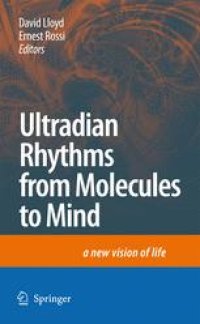
Ebook: Ultradian Rhythms from Molecules to Mind: A New Vision of Life
- Tags: Life Sciences general, Medicine/Public Health general, Neurosciences, Philosophy of Mind, Aesthetics
- Year: 2008
- Publisher: Springer Netherlands
- Edition: 1
- Language: English
- pdf
5. 1. 1 Biological Rhythms and Clocks From an evolutionary perspective, the adaptation of an organism’s behavior to its environment has depended on one of life’s fundamental traits: biological rhythm generation. In virtually all light-sensitive organisms from cyanobacteria to humans, biological clocks adapt cyclic physiology to geophysical time with time-keeping properties in the circadian (24 h), ultradian (24 h) domains (Edmunds, 1988; Lloyd, 1998; Lloyd et al. , 2001; Lloyd and Murray, 2006; Lloyd, 2007; Pittendrigh, 1993; Sweeney and Hastings, 1960) By definition, all rhythms exhibit regular periodicities since they constitute a mechanism of timing. Timing exerted by oscillatory mechanisms are found throughout the biological world and their periods span a wide range from milliseconds, as in the action potential of n- rons and the myocytes, to the slow evolutionary changes that require thousands of generations. In this context, to understand the synchronization of a population of coupled oscillators is an important problem for the dynamics of physiology in living systems (Aon et al. , 2007a, b; Kuramoto, 1984; Strogatz, 2003; Winfree, 1967). Circadian rhythms, the most intensively studied, are devoted to measuring daily 24 h cycles. A variety of physiological processes in a wide range of eukaryotic organisms display circadian rhythmicity which is characterized by the following major properties (Anderson et al. , 1985; Edmunds, 1988): (i) stable, autonomous (self-sustaining) oscillations having a free-running period under constant envir- mental conditions of ca.
Ultradian rhythms play an essential part at all levels of biological organization, providing timekeeping for intracellular processes, playing various roles in intracellular signalling systems and underpinning coherent behaviour in tissues and organs. They are crucial to endocrine and neural performance and in psychobiology. This book brings together the evidence for these findings. In lower eukaryotes short-period rhythms (period 30-70 min) are coupled to an ultradian clock which serves as a central timekeeper. In metazoans, similar rhythms are necessary for intercell communications, and temporal coupling for the coordination of integrated functions of tissues and organs to provide ''homeodynamics'' of the whole organism. Electrical, endocrine and behavioural rhythms characterize both wakefulness and sleep; pathologically disordered states give rise to dynamic diseases. Chapters on human movements, sleep, attention span and alertness indicate the broad span of this subject. A continuum can now be traced from the molecular genetic, through the cellular and neuroendocrine to the behavioural and psychosocial levels. Many of the results presented in this book are recent and novel, and have far-reaching consequences for our understanding of health and disease.
Our first book (published 15 years ago) ended with '' Epilogue :The Unification Hypothesis of Chronobiology-Psychobiology from Molecule to Mind''. In retrospect we can now recognise how this epilogue was a prescient vision of what is now the cutting edge of epigenetics, bioinformatics, systems biology, neuroscience, and the new sciences of consciousness that are the foundation for the emerging vision of life and philosophy in our current era. Each of the four parts of this book are successive iterations towards this new integration of the life sciences from molecule to mind and spirit in the emergent ethos of the future.
Ultradian rhythms play an essential part at all levels of biological organization, providing timekeeping for intracellular processes, playing various roles in intracellular signalling systems and underpinning coherent behaviour in tissues and organs. They are crucial to endocrine and neural performance and in psychobiology. This book brings together the evidence for these findings. In lower eukaryotes short-period rhythms (period 30-70 min) are coupled to an ultradian clock which serves as a central timekeeper. In metazoans, similar rhythms are necessary for intercell communications, and temporal coupling for the coordination of integrated functions of tissues and organs to provide ''homeodynamics'' of the whole organism. Electrical, endocrine and behavioural rhythms characterize both wakefulness and sleep; pathologically disordered states give rise to dynamic diseases. Chapters on human movements, sleep, attention span and alertness indicate the broad span of this subject. A continuum can now be traced from the molecular genetic, through the cellular and neuroendocrine to the behavioural and psychosocial levels. Many of the results presented in this book are recent and novel, and have far-reaching consequences for our understanding of health and disease.
Our first book (published 15 years ago) ended with '' Epilogue :The Unification Hypothesis of Chronobiology-Psychobiology from Molecule to Mind''. In retrospect we can now recognise how this epilogue was a prescient vision of what is now the cutting edge of epigenetics, bioinformatics, systems biology, neuroscience, and the new sciences of consciousness that are the foundation for the emerging vision of life and philosophy in our current era. Each of the four parts of this book are successive iterations towards this new integration of the life sciences from molecule to mind and spirit in the emergent ethos of the future.
Content:
Front Matter....Pages i-xviii
The Ultradian Clock (~40 min) in Yeast (Saccharomyces cerevisiae)....Pages 11-42
ENOX Proteins, Copper Hexahydrate-Based Ultradian Oscillators of the Cells’ Biological Clock....Pages 43-84
Self-Organized Intracellular Ultradian Rhythms Provide Direct Cell-Cell Communication....Pages 85-104
Phosphorylation Dynamics in Mammalian Cells....Pages 105-128
Is There a Mitochondrial Clock?....Pages 129-144
Ultradian and Circadian Rhythms: Experiments and Models....Pages 147-161
Ultradian Lovesong Rhythms in Drosophila....Pages 163-173
Mid-range Ultradian Rhythms in Drosophila and the Circadian Clock Problem....Pages 175-199
Tidal Rhythms....Pages 201-226
Pulsatile Hormone Secretion: Mechanisms, Significance and Evaluation....Pages 229-248
Ultradian Rhythms as the Dynamic Signature of Life....Pages 249-260
The Mammalian Circadian Timekeeping System....Pages 261-279
Ultradian Cognitive Performance Rhythms During Sleep Deprivation....Pages 283-301
High Frequency EEG and Its Relationship to Cognitive Function....Pages 303-341
Total Sleep Deprivation and Cognitive Performance: The Case for Multiple Sources of Variance....Pages 343-389
Open Questions on Mind, Genes, Consciousness, and Behavior: The Circadian and Ultradian Rhythms of Art, Beauty, and Truth in Creativity....Pages 391-411
Genes, Sleep and Dreams....Pages 413-429
Epilogue: A New Vision of Life....Pages 431-439
Back Matter....Pages 441-450